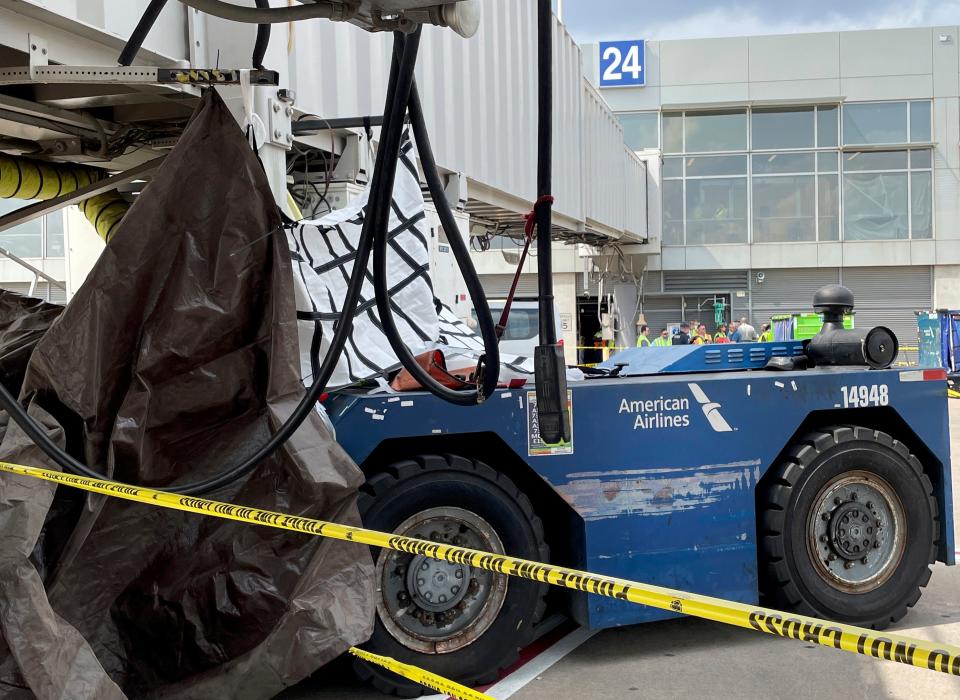Exclusive: American Airlines employee killed driving tug with history of issues, police report
A ground service vehicle used by an American Airlines employee during a fatal collision at Austin–Bergstrom International Airport earlier this year was known by some of the airline’s staff to have “several mechanical issues,” including a reported brake failure that led to a guardrail collision 10 days before the incident, according to a police report obtained by the American-Statesman.
On April 20, the employee, Michal Ingraham, had started the pushback — a type of vehicle used to tow large aircraft — shortly before it “accelerated faster than normal and then veered to the right,” one witness told police. The 14-ton pushback (sometimes referred to as a tug or a tractor by authorities in their report) then crashed into a jet bridge by the Barbara Jordan Terminal's Gate 24, pinning the 37-year-old Austin resident between the pushback and the underside of the jet bridge.
One of two 911 callers told dispatch he yelled to Ingraham to push the brakes after it appeared the pushback's “accelerator got stuck” before the crash.
Authorities were called to the scene at 2:02 p.m. Just over 15 minutes later, Ingraham was pronounced dead. A Travis County medical examiner later concluded the death was the result of blunt force injuries, and toxicology tests found no traces of drugs or alcohol in Ingraham’s system.
The medical examiner and police came to the same conclusion: The death was an accident. That was despite the suggestions from an American Airlines corporate investigator that it could have been a suicide, according to the reports.

Little information was released after the incident that killed Ingraham, whom one colleague who talked to police described as a "diligent and hard-working individual." Hailing from Washington and living for a time in New Mexico, Ingraham was known for his strong faith and belief in a higher power.
One 911 caller said Ingraham had been working at the Austin airport for less than a year. During that time, he posted dozens of photos from work on his personal Facebook page, many showing the large aircraft with Central Texas' iconic and colorful sunsets as a backdrop. He showed off different aspects of his job, and the aircraft models he worked with, including his favorite: the CRJ-700, which he called the "bullet plane."
Last week, the Statesman obtained and reviewed Austin Police Department reports, Austin-Travis County EMS reports, autopsy records and 911 calls. The details in the reports, first revealed by the newspaper, recount elements of the incident that could be informing an ongoing investigation by the U.S. Department of Labor's Occupational Safety and Health Administration.
The scope and status of the federal investigation was unclear Friday. A Department of Labor spokesperson did not respond to inquiries Friday about the findings in the police reports.
An anonymous call about upkeep on the pushback
On April 24 — four days after the incident — Austin police received an anonymous call with a tip about the case, according to police reports.
The caller told police the pushback used by Ingraham had been “marked out of service numerous times for failed brakes.” Despite this, the pushback was not serviced and remained in use, the caller said, suggesting police investigate the pushback's maintenance records.
On April 27, a detective with the vehicular homicide unit, Kerry Kelly, said Austin police had received an email alleging the same pushback had been in a collision 10 days before the fatal April 20 incident as a result of a brake failure, according to the report. The report does not state who sent the email.
Elizabeth Ferrer, a spokesperson for the city-owned airport, confirmed there was a guardrail collision on airport property April 10, but it was unclear whether the collision involved the same machine. She declined to comment further, citing the ongoing investigation.
Though the pushback bears an American Airlines logo on the side, maintenance and upkeep of the vehicles are managed by Menzies Airlines, one Menzies employee told Kelly.
Menzies is a U.K.-based company, but it has a Texas office in Grapevine. When the Statesman reached out to Menzies’ general manager over Austin operations, Dehron Pistilli, he declined to comment, saying he was not in a position to speak about the incident.
On May 4, Kelly wrote in a report that she had received some maintenance records from Pistilli. However, he had not sent any work order requests relating to an April 10 brake failure despite Kelly explicitly asking for them.
Whether maintenance records exist for the reported April 10 incident or were provided to authorities was unclear Friday. Also unclear was whether the reported brake issue was addressed by Menzies.
On June 8, Austin police closed their investigation, deferring their findings to OSHA investigators. In the report, Detective Melony Bowman, with the vehicular homicide unit, wrote, "This case is determined to be an accidental death and is non-criminal therefore will be cleared administratively."
American Airlines investigator suggests death was a suicide
In the hours after the fatal accident, American Airlines told media outlets, “We are devastated by the accident involving a team member at Austin-Bergstrom International Airport. Our thoughts and prayers are with the family and our local team members.”
But as the airline publicly shared its sentiments, one American Airlines employee quickly began investigating the fatal crash.
One day after the incident, Lynn Fast, a corporate investigator for the Fort Worth-based airline, contacted Austin police, stating he had "obtained information overnight indicating that the fatal incident was a suicide and not an accident," according to the police report.
Fast told police he had 30 years of law enforcement experience and came to believe Ingraham's death was a suicide after contacting Ingraham's father, the police report said. During their conversation, Fast told police the father apologized for the ordeal — a sentiment Fast said he "found strange."
State records show Fast worked as a licensed peace officer for the Texas Department of Public Safety from 1993 to 1994 and the Dallas-area Addison Police Department from 1995 to 2002. His public LinkedIn profile states that he worked 20 years at the U.S. Department of Homeland Security, followed by two years at the FBI, before joining American Airlines last autumn.
Talking with police, Fast pointed to recent Facebook posts by Ingraham as evidence that his death was a suicide, according to the report. Which Facebook posts Fast was referencing is not clear or detailed in the report.
However, Bowman — who said she believed she had seen the Facebook posts — disagreed.
"I explained that several AA employees were interviewed on site and no one had mentioned anything that would indicate this was intentional and further stated that everyone we spoke with stated that the tug he was driving was known to have issues," Bowman wrote in the police report.
Bowman asked Fast who provided the information and how it would indicate the incident was a suicide, according to the report, but Fast "did not provide that information."

Afterward, Bowman contacted Ingraham's father, asking whether his son had any mental health diagnoses or medication for mental illness or had "spoken in an alarming way" that would indicate he was depressed, suffered from anxiety or "would do anything to harm himself."
Ingraham's father said no, saying that his son intentionally killing himself "would be a shock to him," according to the report.
Austin police ultimately classified the case as an accidental death — not a suicide.
Fast did not return a phone call or an email inquiry from the Statesman on Friday. Attempts by the Statesman to contact the family were unsuccessful last week.
American Airlines did not answer questions from the Statesman about Fast, his investigation, interactions with police or his suggestion that the death was a suicide.
The company did issue a statement:
"We are heartbroken by the accident involving a team member at Austin-Bergstrom International Airport (AUS) in April," said Sarah Jantz, an American Airlines spokesperson. "Our thoughts and prayers are with the family and our local team members. We are focused on ensuring that all involved have the support they need during this difficult time. American is fully cooperating in this open investigation."
OSHA investigation continues
Though the Austin police investigation is closed, the federal OSHA investigation is ongoing, though its scope is not clear.
In the report, Austin detectives said they deferred their findings about the April 10 collision to OSHA.
"OSHA ... are planning to have a specialist examine the tug and any mechanical malfunction that could have occurred," Kelly wrote May 4.
Online OSHA records show that an investigation by the agency's Austin office into Menzies Aviation (Texas) Inc. began April 20 — the same day as the fatal incident. The case — the sole incident listed for Menzies' Texas outfit in the database, which dates back to 1973 — was listed as "open" Friday.
The online records show OSHA's Austin office started another investigation into American Airlines on the same day. That case was also listed as "open."
An OSHA citation and proposed penalty would have to be issued within six months of the incident, though the investigation can take longer, depending on the complexity of the case.
This article originally appeared on Austin American-Statesman: American Airlines employee killed driving faulty machine, police say

